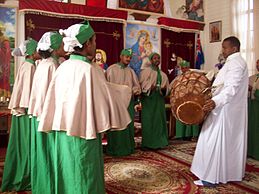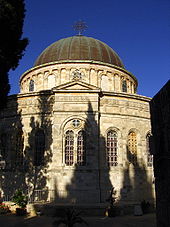- Ethiopian Orthodox Tewahedo Church
-
Ethiopian Orthodox Tewahedo Church
የኢትዮጵያ ኦርቶዶክስ ተዋሕዶ ቤተ ክርስቲያንFounder Frumentius Independence 1959 from the Coptic Orthodox Church of Alexandria Recognition Oriental Orthodox Primate His Holiness Abune Paulos, Patriarch and Catholicos of Ethiopia, Ichege of the See of St. Tekle Haymanot, and Archbishop of Axum Headquarters Addis Ababa, Ethiopia Territory Ethiopia Possessions Sudan, Djibouti, Kenya, South Africa, Jerusalem, Europe, United States, Canada, Caribbean, Latin America, Australia, Nigeria Language Ge'ez Adherents 45,000,000 Website Official Website of the Patriarchate (English)[dead link] The Ethiopian Orthodox Tewahedo Church (Amharic: የኢትዮጵያ ኦርቶዶክስ ተዋሕዶ ቤተ ክርስቲያን?; Transliterated Amharic: Yäityop'ya ortodoks täwahedo bétäkrestyan) is the predominant Oriental Orthodox Christian church in Ethiopia. The Ethiopian Church was administratively part of the Coptic Orthodox Church until 1959, when it was granted its own Patriarch by Coptic Orthodox Pope of Alexandria and Patriarch of All Africa, Cyril VI. It should not be confused with the Ethiopian Catholic Church, which is a Chalcedonian church.
One of the few pre-colonial Christian churches of Sub-Saharan Africa, the Ethiopian Church has a membership of between 40 and 45 million,[1] the overwhelming majority of whom live in Ethiopia,[2] and is thus the largest of all Oriental Orthodox churches. The Ethiopian Orthodox Tewahedo Church is a founding member of the World Council of Churches.[3]
Tewahedo (Te-wa-hido) (Ge'ez ተዋሕዶ tawāhidō, modern pronunciation tewāhidō) is a Ge'ez word meaning "being made one" or "unified"; it is cognate with the Arabic term توحيد tawḥīd, used in Islam to mean worshipping Allah alone. This word refers to the Oriental Orthodox belief in the one single unified Nature of Christ; i.e., a belief that a complete, natural union of the Divine and Human Natures into One is self-evident in order to accomplish the divine salvation of humankind, as opposed to the "two Natures of Christ" belief (unmixed, but unseparated Divine and Human Natures, called the Hypostatic Union) which is held by the Roman Catholic and Eastern Orthodox churches. According to the Catholic Encyclopedia article on the Henotikon[4]: the Patriarchs of Alexandria, Antioch, and Jerusalem, and many others, all refused to accept the "two natures" doctrine decreed by the Council of Chalcedon in 451, thus separating them from the Roman Catholic and Eastern Orthodox — who themselves separated from one another later on in the East-West Schism in 1054, although not over Christological views.
The Oriental Orthodox Churches, which today include the Coptic Orthodox Church of Alexandria, the Armenian Apostolic Church, the Syriac Orthodox Church, the Malankara Orthodox Church of India, the Ethiopian Orthodox Church, and the Eritrean Orthodox Tewahedo Church, are referred to as "Non-Chalcedonian", and, sometimes by outsiders as "monophysite" (meaning "One Single Nature", in reference to Christ). However, these Churches themselves describe their Christology as miaphysite (meaning "One United Nature", in reference to Christ; the translation of the word "Tewahedo").
Contents
History
Origins
Part of a series on Eastern Christianity 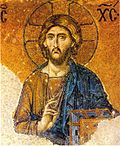
History Orthodox Church History
Specific regions:
Byzantine Empire
Ecumenical council
Christianization of Bulgaria
Christianization of Kievan Rus'
East-West Schism
Asian Christianity
Coptic Egypt · UkraineTraditions Orthodox Church
Others:
Oriental Orthodoxy
Ethiopian Tewahedo Church
Coptic Church
Church of the East
Eastern Catholic Churches
Syriac ChristianityLiturgy and worship Sign of the cross
Divine Liturgy
Iconography
Asceticism
OmophorionTheology Hesychasm · Icon
Apophaticism
Filioque clause
Miaphysitism
Monophysitism
Diophysitism
Nestorianism
Theosis · Theoria
Phronema · Philokalia
Praxis · Theotokos
Hypostasis · Ousia
Essence vs. Energies
MetousiosisThe Ethiopian Church claims its earliest origins from the royal official said to have been baptized by Philip the Evangelist (not to be confused with Philip the Apostle), one of the seven deacons:
- Then the angel of the Lord said to Philip, Start out and go south to the road that leads down from Jerusalem to Gaza. So he set out and was on his way when he caught sight of an Ethiopian. This man was a eunuch, a high official of the Kandake (Candace) Queen of Ethiopia in charge of all her treasure. (Acts, 8:27)
The passage continues by describing how Philip helped the Ethiopian treasurer understand a passage from Isaiah that the Ethiopian was reading. After the Ethiopian received an explanation of the passage, he requested that Philip baptize him, and Philip did so. The Ethiopic version of this verse reads "Hendeke" (ህንደኬ); Queen Gersamot Hendeke VII was the Queen of Ethiopia from ca. 42 to 52.
Orthodox Christianity became the established church of the Ethiopian Axumite Kingdom under king Ezana in the 4th century through the efforts of a Syrian Greek named Frumentius, known in Ethiopia as Abba Selama, Kesaté Birhan ("Father of Peace, Revealer of Light"). As a youth, Frumentius had been shipwrecked with his brother Aedesius on the Eritrean coast. The brothers managed to be brought to the royal court, where they rose to positions of influence and converted Emperor Ezana to Christianity, causing him to be baptised. Ezana sent Frumentius to Alexandria to ask the Patriarch, St. Athanasius, to appoint a bishop for Ethiopia. Athanasius appointed Frumentius himself, who returned to Ethiopia as Bishop with the name of Abune Selama.
From then on, until 1959, the Pope of Alexandria, as Patriarch of All Africa, always named an Egyptian (a Copt) to be Abuna or Archbishop of the Ethiopian Church.
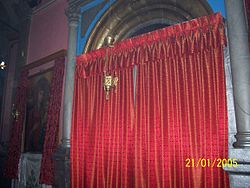 Ethiopian Church in Jerusalem
Ethiopian Church in Jerusalem
Middle Ages
Union with the Coptic Orthodox Church continued after the Arab conquest of Egypt. Abu Saleh records in the 12th century that the patriarch always sent letters twice a year to the kings of Abyssinia (Ethiopia) and Nubia, until Al Hakim stopped the practice. Cyril, 67th patriarch, sent Severus as bishop, with orders to put down polygamy and to enforce observance of canonical consecration for all churches. These examples show the close relations of the two churches concurrent with the Middle Ages.
In 1439, in the reign of Zara Yaqob, a religious discussion between Abba Giyorgis and a French visitor had led to the dispatch of an embassy from Ethiopia to the Vatican.
Jesuit interim
The period of Jesuit influence, which broke the connection with Egypt, began a new chapter in Church history. The initiative in the Roman Catholic missions to Ethiopia was taken, not by Rome, but by Portugal, as an incident in the struggle with the Muslim Ottoman Empire and Sultanate of Adal for the command of the trade route to India by the Red Sea.
In 1507 Matthew, or Matheus, an Armenian, had been sent as an Ethiopian envoy to Portugal to ask for aid against the Adal Sultanate. In 1520 an embassy under Dom Rodrigo de Lima landed in Ethiopia (by which time Adal had been remobilized under Ahmad ibn Ibrihim al-Ghazi). An interesting account of the Portuguese mission, which lasted for several years, was written by Francisco Álvares, the chaplain.
Later, Ignatius Loyola wished to take up the task of conversion, but was forbidden. Instead, the pope sent out João Nunes Barreto as patriarch of the East Indies, with Andre de Oviedo as bishop; and from Goa envoys went to Ethiopia, followed by Oviedo himself, to secure the king's adherence to Rome. After repeated failures some measure of success was achieved under Emperor Susenyos, but not until 1624 did the Emperor make formal submission to the pope. Susenyos made Roman Catholicism the official state religion, but was met with heavy resistance by his subjects, and the authorities of the Ethiopian Orthodox Church, and eventually had to abdicate in 1632 to his son, Fasilides, who promptly restored the state religion to Ethiopian Orthodox Christianity. He then expelled the Jesuits in 1633, and in 1665, Fasilides ordered that all Jesuit books (the Books of the Franks) be burned.
Recent history
In recent years, the Ethiopian church experienced a series of reforms. The earliest was in the 19th century with the publication of an Amharic translation of the Bible. Largely the work of Abu Rumi, who worked on this monumental effort for ten years in Cairo, this version, with some changes, held sway until Emperor Haile Selassie ordered a new translation which appeared in 1960/1.[5] Haile Selassie also played a prominent role in further reforms of the church, which included encouraging the distribution of Abu Rumi's translation throughout Ethiopia,[6] as well as his promotion of improved education of clergy, the founding of the Theological College of the Holy Trinity Church in December 1944 being a significant step in the Emperor's effort.[7] A third development came after his restoration to Ethiopia, when Emperor Haile Selassie issued on 30 November 1942 a new law reforming the Church, Decree Number 2 of 1942. The primary objectives of this decree were to put the finances of the church in order, to create a central fund for its activities, and to set forth requirements and steps for the appointment of clergy—which had been embarrassingly lax until then.[8]
The Coptic and Ethiopian Churches reached an agreement on 13 July 1948, that led to autocephaly for the Ethiopian Church. Five bishops were immediately consecrated by the Coptic Pope of Alexandria and Patriarch of All Africa, empowered to elect a new Patriarch for their church, and the successor to Abuna Qerellos IV would have the power to consecrate new bishops.[9] This promotion was completed when Coptic Orthodox Pope Joseph II consecrated an Ethiopian-born Archbishop, Abuna Basilios, 14 January 1951. Then in 1959, Pope Cyril VI of Alexandria crowned Abuna Baslios as the first Patriarch of Ethiopia.
Patriarch Abune Basilios died in 1971, and was succeeded that year by Patriarch Abune Tewophilos. With the fall of Emperor Haile Selassie in 1974, the Ethiopian Orthodox Tewahedo Church was disestablished as the state church. The new Marxist government began nationalising property (including land) owned by the church. Patriarch Abune Tewophilos was arrested in 1976 by the Marxist Derg military junta, and secretly executed in 1979. The government ordered the church to elect a new Patriarch, and Abune Takla Haymanot was enthroned. The Coptic Orthodox Church refused to recognize the election and enthronement of Abune Tekle Haymanot on the grounds that the Synod of the Ethiopian Church had not removed Abune Tewophilos and that the government had not publicly acknowledged his death, and he was thus still the legitimate Patriarch of Ethiopia. Formal relations between the two churches were halted, although they remained in communion with each other. Formal relations between the two churches resumed on July 13, 2007.[10]
Patriarch Abune Tekle Haymanot proved to be much less accommodating to the Derg regime than it had expected, and so when the Patriarch died in 1988, a new Patriarch with closer ties to the regime was sought. The Archbishop of Gondar, a member of the Derg-era Ethiopian Parliament, was elected and enthroned as Patriarch Abuna Merkorios. Following the fall of the Derg regime in 1991, and the coming to power of the EPRDF government, Patriarch Abune Merkorios abdicated under public and governmental pressure. The church then elected a new Patriarch, Abune Paulos, who was recognized by the Coptic Orthodox Pope of Alexandria. The former Patriarch Abune Merkorios then fled abroad, and announced from exile that his abdication had been made under duress and thus he was still the legitimate Patriarch of Ethiopia. Several bishops also went into exile and formed a break-away alternate synod. This exiled synod is recognized by some Ethiopian Churches in North America and Europe who recognize Patriarch Abune Merkorios, while the synod inside Ethiopia continues to uphold the legitimacy of Patriarch Abune Paulos.
Following the independence of Eritrea as a nation in 1993, the Coptic Orthodox Church in 1994 appointed an Archbishop for the Eritrean Orthodox Tewahedo Church, which in turn obtained autocephaly in 1998 with the reluctant approval of its mother synod. That same year the first Eritrean Patriarch was consecrated.
As of 2005, there are many Ethiopian Orthodox churches located throughout the United States and other countries to which Ethiopians have migrated (Archbishop Yesehaq 1997). The church claims more than 38 million members in Ethiopia, forming about half the country's population.
Practices and beliefs
The faith and practice of most Orthodox Ethiopian Christians includes elements from Miaphysite Christianity as it has developed in Ethiopia over the centuries. According to researchers Thomas P. Ofcansky and LaVerle Berry, as with many Christian traditions, Ethiopian Orthodox Christianity includes elements from the local non-Christian heritage that are rejected by more educated church members, but usually shared by the ordinary priest.[11] Christian elements include God (in Ge'ez / Amharic, ′Egziabeher, lit. "Lord of the Universe"), the angels, and the saints, besides others.[11] According to the Ethiopian Orthodox Church itself, there are no non-Christian elements in the religion other than those from the Old Testament, or Higge 'Orit (ሕገ ኦሪት), to which are added those from the New Testament, or Higge Wongiel (ሕገ ወንጌል).[12] A hierarchy of "Kidusan" (angelic messengers and saints) conveys the prayers of the faithful to God and carries out the divine will, so when an Ethiopian Christian is in difficulty, he or she appeals to these as well as to God. In more formal and regular rituals, priests communicate on behalf of the community, and only priests may enter the inner sanctum of the usually circular or octagonal church where the tabot ("ark") dedicated to the church's patron saint is housed. On important religious holidays, the tabot is carried on the head of a priest and escorted in procession outside the church. It is the tabot, not the church, which is consecrated. Only those who feel pure, have fasted regularly, and have generally conducted themselves properly may enter the middle ring to receive communion. At many services, most parish members remain in the outer ring, where debteras sing hymns and dance.[11]
Ethiopian Orthodox believers are strict Trinitarians,[13] maintaining the Orthodox teaching that God is united in three persons: Father, Son, and Holy Spirit. This concept is known as səllasé, Ge'ez for "Trinity".
Weekly services constitute only a small part of an Ethiopian Orthodox Christian's religious observance. Several holy days require prolonged services, singing and dancing, and feasting. An important religious requirement, however, is the keeping of fast days. All devout believers are to maintain the full schedule of fasts, comprising 250 days.
- Fast for Hudadi or Abiye Tsome (Lent), 56 days.
- Fast of the Apostles, 10–40 days, which the Apostles kept after they had received the Holy Spirit. It begins after Pentecost.
- The fast of Assumption, 16 days.
- The gahad of Christmas (on the eve of Christmas).
- The fast preceding Christmas, 40 days (Advent). It begins with Sibket on 15th Hedar and ends on Christmas Eve with the feast of Gena and the 28th of Tahsas.
- The fast of Nineveh, commemorating the preaching of Jonah. It comes on Monday, Tuesday and Wednesday of the third week before Lent.
- The gahad of Epiphany, fast on the eve of Epiphany.
In addition to standard holy days, most Christians observe many saint's days. A man might give a small feast on his personal saint's day. The local voluntary association (called the maheber) connected with each church honors its patron saint with a special service and a feast two or three times a year.[11]
Exorcism
Priests intervene and perform exorcisms on behalf of those believed to be afflicted by demons or buda. According to a 2010 Pew Research Center study, 74% of Christians in Ethiopia claim to have experienced or witnessed an exorcism.[14] Demon-possessed persons are brought to a church or prayer meeting.[15] Often, when an ill person has not responded to modern medical treatment, the affliction is attributed to demons.[15] Unusual or especially perverse deeds, particularly when performed in public, are symptomatic of a demoniac.[15] Superhuman strength – such as breaking one's bindings, as described in the New Testament accounts – along with glossolalia are observed in the afflicted.[15] Amsalu Geleta, in a modern case study, relates elements that are common to Ethiopian Christian exorcisms:
It includes singing praise and victory songs, reading from the Scripture, prayer and confronting the spirit in the name of Jesus. Dialogue with the spirit is another important part of the exorcism ceremony. It helps the counselor (exorcist) to know how the spirit was operating in the life of the demoniac. The signs and events mentioned by the spirit are affirmed by the victim after deliverance.[15]
The exorcism is not always successful, and Geleta notes another instance in which the usual methods were unsuccessful, and the demons apparently left the subject at a later time. In any event, "in all cases the spirit is commanded in no other name than the name of Jesus."[15]
Distinctive traits
Biblical canon
The Tewahedo Church Canon contains 81 books. This canon contains the books accepted by other Orthodox Christians.
- The Narrower Canon also contains Enoch, Jubilees, and I II III Meqabyan. (These are unrelated to the Greek I, II, III Maccabees with which they are often confused.) The canonical Enoch differs from the editions of the Ge'ez manuscripts in the British Museum and elsewhere (A-Q) used by foreign scholars (OTP), for example in treatment of the Nephilim of Genesis 6[citation needed]. The current 81 book version was published in 1986, containing the same text as previously published in the Haile Selassie Version of the Bible, only with some minor modifications to the New Testament translation.
- Some books speak of the Broader Canon has in fact never been published, but is said to include all of the Narrower Canon, as well as additional books in an appendix to the New Testament use by the early church: two Books of the Covenant, four Books of Sinodos, an Epistle to Clement,[dubious ] and the Didascalia. These may not all bear close resemblance to works of these titles known in the west.
Language
The divine services of the Ethiopian Church are celebrated in the Ge'ez language, which has been the language of the Church at least since the arrival of the Nine Saints (Abba Pantelewon, Abba Gerima (Isaac, or Yeshaq), Abba Aftse, Abba Guba, Abba Alef, Abba Yem’ata, Abba Liqanos, and Abba Sehma), who fled persecution by the Byzantine Emperor after the Council of Chalcedon (451)[citation needed]. The Septuagint Greek version was originally translated into Ge'ez, but later revisions show clear evidence of the use of Hebrew, Syriac, and Arabic sources. The first translation into a modern vernacular was done in the 19th century by a man who is usually known as Abu Rumi. Later, Haile Selassie sponsored Amharic translations of the Ge'ez Scriptures during his reign, one before World War II and one afterwards. Sermons today are usually delivered in the local language.
Architecture
There are many monolithic churches in Ethiopia, most famously the above-mentioned twelve churches at Lalibela. After these, two main types of architecture are found—one basilican, the other native. The Church of Our Lady Mary of Zion at Axum is an example of the basilican design, though the early basilicas are nearly all in ruin. These examples show the influence of those architects who, in the 6th century, built the basilicas at Sanʻāʼ and elsewhere in the Arabian Peninsula. There are two forms of native churches: one oblong, traditionally found in Tigray; the other circular, traditionally found in Amhara and Shewa (though either style may be found elsewhere). In both forms, the sanctuary is square and stands clear in the center, and the arrangements are based on Jewish tradition. Walls and ceilings are adorned with frescoes. A courtyard, circular or rectangular, surrounds the body of the church. Modern Ethiopian churches may incorporate the basilican or native styles, and utilize contemporary construction techniques and materials. In rural areas, the church and outer court are often thatched, with mud-built walls.
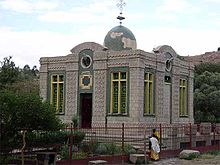 The Chapel of the Tablet at the Church of Our Lady Mary of Zion allegedly houses the original Ark of the Covenant.
The Chapel of the Tablet at the Church of Our Lady Mary of Zion allegedly houses the original Ark of the Covenant.
Ark of the Covenant
The Ethiopian church claims that one of its churches, Our Lady Mary of Zion, is host to the original Ark of the Covenant that Moses carried with the Israelites during the Exodus. However, only one priest is allowed into the building where the Ark is located, ostensibly due to dangerous biblical warnings. As a result, international scholars doubt that the original Ark is truly there, although a case has been put forward by controversial popular writer Graham Hancock in his book The Sign and the Seal.
Throughout Ethiopia, Orthodox churches are not considered churches until the local bishop gives them a tabot, a replica of the tablets in the original Ark of the Covenant. The tabot is at least six inches (15 cm) square and made from alabaster, marble, or wood (see acacia). It is always kept in ornate coverings on the Altar. Only priests are allowed to touch the tabot. In an elaborate procession, the tabot is carried around the outside of the church amid joyful song and on the feast day of that particular church's namesake. On the great Feast of T'imk'et, known as Epiphany or Theophany in Europe; group of churches send their tabots to celebrate the occasion on a common location where a pool of water or a river is located.
Similarities to Judaism
The Ethiopian church places a heavier emphasis on Old Testament teachings than one might find in any of the Eastern Orthodox, Roman Catholic or Protestant churches, and its followers adhere to certain practices that one finds in Orthodox or Conservative Judaism. Ethiopian Christians, like some other Eastern Christians, traditionally follow dietary rules that are similar to Jewish Kashrut, specifically with regard to how an animal is slaughtered. Similarly, pork is prohibited, though unlike Rabbinical Kashrut, Ethiopian cuisine does mix dairy products with meat. Women are prohibited from entering the church during menses; they are also expected to cover their hair with a large scarf (or shash) while in church, per 1 Cor. 11. As with Orthodox synagogues, men and women are seated separately in the Ethiopian church, with men on the left and women on the right (when facing the altar). (Women covering their heads and separation of the sexes in churchhouses officially is common to some Oriental Orthodox, Eastern Orthodox and (before the 1960s) to Catholic Christians, as well as many conservative Protestant and Anabaptist traditions; it also is the rule in some non-Christian religions, Islam and Orthodox Judaism among them.) Ethiopian Orthodox worshippers remove their shoes when entering a church, in accordance with Exodus 3:5 (in which Moses, while viewing the burning bush, is commanded to remove his shoes while standing on holy ground). Furthermore, both the Sabbath (Saturday), and the Lord's Day (Sunday) are observed as holy, although more emphasis, because of the Resurrection of Christ, is laid upon Sunday.
Bishops
These are bishops lead by the current patriarch Abuna Paulos and the synod in Ethiopia:
- Abuna Paulos, patriarch
- Bishop Matthias in Canadian diocese, residing in London, Ontario
In the United States there are the following bishops:
- Abuna Kewustos, archbishop of Washington, D.C.
- Aba (Abuna) Zekarias, archbishop in New York City
- Aba Ewastetewos (Eustathius), archbishop in Berkeley, California
The South of America:
- Abuna Thaddaeus, archbishop of the Caribbean and Latin America
there is also a jurisdiction in Western Europe:
- Archbishop Yohannes of Europe, in London
The church has 57 bishops and 44 dioceses.
See also
- Abuna
- Christianity in Ethiopia
- Eritrean Orthodox Tewahedo Church
- Ethiopian Catholic Church
- List of Abunas of Ethiopia
- List of Orthodox Churches
- Christianity in India
References
- ^ "Ethiopia: Orthodox Head Urges Churches to Work for Better World". http://allafrica.com/stories/200609121188.html. Retrieved 2006-09-13.
- ^ Berhanu Abegaz, "Ethiopia: A Model Nation of Minorities" (accessed 6 April 2006)
- ^ "Ethiopian Orthodox Tewahedo Church", World Council of Churches website (accessed 2 June 2009)
- ^ [1]
- ^ Edward Ullendorff, Ethiopia and the Bible (Oxford: British Academy, 1988), p. 66
- ^ Margary Perham, The Government of Ethiopia, second edition (London: Faber and Faber, 1969), pp. 121f
- ^ Perham, Government of Ethiopia, p. 132
- ^ Perham, Government of Ethiopia, pp. 130
- ^ Discussed in fuller detail by Perham, Government of Ethiopia, pp. 126-130
- ^ "Common Declaration" of Pope Shenoudah III, Catholicos Aram I, and Patriarch Paulos - News and Media of the Armenian Orthodox Church, 22 July 2007
- ^ a b c d Turner, John W. "Ethiopian Orthodox Christianity: Faith and practices". A Country Study: Ethiopia (Thomas P. Ofcansky and LaVerle Berry, eds.) Library of Congress Federal Research Division (1991). This article incorporates text from this source, which is in the public domain.[2].
- ^ EOTC Doctrine
- ^ Doctrine of the Ethiopian Orthodox Church
- ^ "Ten things we have learnt about Africa". BBC News. April 15, 2010. http://news.bbc.co.uk/2/hi/africa/8620249.stm. Retrieved April 15, 2010. ""In Ethiopia, 74% of Christians say they have experienced or witnessed the devil or evil spirits being driven out of a person""
- ^ a b c d e f Geleta, Amsalu Tadesse. "Case Study: Demonization and the Practice of Exorcism in Ethiopian Churches". Lausanne Committee for World Evangelization, Nairobi, August 2000.
- Archbishop Yesehaq. 1997. The Ethiopian Tewahedo Church: an Integrally African Church. Winston-Derek Publishers.
- Mikre-Sellassie Gebre-Amanuel. 1993. “The Bible and Its Canon in the Ethiopian Orthodox Church.” The Bible Translator 44/1:111-123.
 This article incorporates text from a publication now in the public domain: Chisholm, Hugh, ed (1911). Encyclopædia Britannica (11th ed.). Cambridge University Press.
This article incorporates text from a publication now in the public domain: Chisholm, Hugh, ed (1911). Encyclopædia Britannica (11th ed.). Cambridge University Press.
External links
- Listen and Watch Ethiopian Orthodox Tewahedo Church Songs, Begena and Preaching (Tewahedo Live)
- Ethiopian Orthodox Timket Ceremony in Gondar (Video)
- Divine Liturgy of the Ethiopian Orthodox Church
- Ethiopian Orthodox Tewahedo Church Directory (Ethiopian Orthodox Tewahedo Church Directory -the oldest site)
- Ethiopian Orthodox Church Directory Directory of Ethiopian Orthodox Churches
- Ethiopian Review's Directory of Ethiopian churches
- Ethiopian Religions - Christianity, Islam, Judaism & Paganism
- Bilingual Ethiopian Orthodox Tewahedo Church site - English version
- Ethiopian Orthodox Tewahedo Church Info(A place to share knowledge of Our Faith and Practice of Worship)
- EOTC INFO Provides Basic Information and more for members born outside of Ethiopia
- List of Ethiopian Orthodox Tewahedo Church websites
- Ethiopian Orthodox Tewahedo Church (Ethiopian Orthodox Tewahedo Church -the oldest site)
- Tewahedo Songs & Records
- Ethiopian Orthodox Tewahedo Church in Phoenix
- Ethiopian Orthodox Archdiocese of the Caribbean & Latin America
- CNEWA article: Ethiopian Orthodox Tewahedo Church
- Historical Evolution of Ethiopian Anaphoras
- Abbink, J. A Bibliography on Christianity in Ethiopia. Leiden: African Studies Centre, 2003 (PDF)
- Biblical Canon
- AN INTRODUCTION TO Ethiopic Christian Literature BY J. M. HARDEN, D.D., LL.D. Canon of St. Patrick's, Dublin, 1926
- The Ethiopian Orthodox Tewahedo Church faith and Order -in Amharic
- The Ethiopian Orthodox Tewahedo Church faith and Order
- Ethiopian Icons Through The Centuries - Images from the Church
- Ethiopian Orthodox Tewahedo Church outside of Ethiopia - includes music and preaching
- Ethiopian Crucifixes Gallery
Autocephalous and Autonomous Churches of Oriental Orthodoxy Autocephalous Churches Autonomous Churches Alexandria: Britain · France
Antioch: Malankara
Armenia: Cilicia · Constantinople · JerusalemCategories:- Ethiopian Orthodox Tewahedo Church
- Members of the World Council of Churches
- Religious organizations established in 1959
- Oriental Orthodox organizations established in the 20th century
- Christian denominations, unions, and movements established in the 20th century
- Non-Chalcedonianism
Wikimedia Foundation. 2010.



